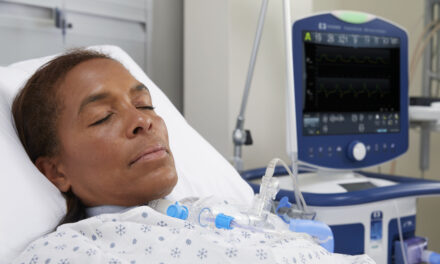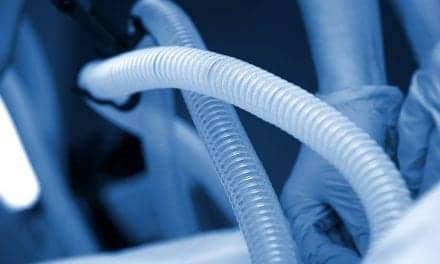Combining lung-protective ventilation strategies and compliance-improving techniques will help clinicians keep patients ventilated at safe pressures.
By Patrick Yorio, RRT
Protecting the lung from potential damage is not a new concept. Complications of positive-pressure ventilation are described as barotrauma and are accompanied by a decrease in cardiac output.[1]
The damage done through barotrauma is considered catastrophic in that pneumothorax can become tension pneumothorax (which is life threatening). The precaution undertaken to protect patients from this damage has typically been to vent off occasional high delivery pressures. The pressure buildup is usually due to a volume ventilator’s attempt to deliver the mandatory breath in the presence of an obstruction.
Recent studies,[2-3] however, point to the need to limit the amount of pressure used to deliver given tidal volumes. Continued studies[4-5] on ventilator-induced lung injury (VILI) pointed to overdistention caused by excessive volume delivery as responsible for injury. With volutrauma, there is the possibility of causing damage to the lung parenchyma through injuries related to overinflation (stretch) or opening and closing (stress).[4]
Growing concern regarding VILI has prompted RCPs to consider substitutes for traditional ventilation methods. Overdistention of the lungs is the cause of airway remodeling,[6] and increased permeability of the epithelial cells in the lung parenchyma, which leads to edema. Oxygen radicals are released, along with toxins causing inflammation and, eventually, fibrosis and death.[5,7,8] If mechanical ventilation is the cause of this damage,[1] then it is necessary to examine:
- How much volume is needed to trigger this phenomenon;[4]
- How this trigger can be measured;[7]
- What can be done to prevent this;[5]
- Whether the treatment outweighs the risk.
The movement favoring protective lung ventilation has not been accepted by all who practice mechanical ventilation. The early 1970s yielded groups focusing on pressure or volume in the ventilation of infants and children. At that time, adult ventilation was uncontroversial. The adult respiratory distress syndrome (ARDS) was still being defined as progressive pulmonary consolidation,[9] and the only argument surrounding pressure limits was that super positive end-expiratory pressure (PEEP) should be limited to 44 cm H2O.[10] The concern for pressure regulation has since entered adult intensive care, and the conventional approach to adult ventilation has been questioned for more than a decade.
Conventional Ventilation
Conventional ventilation can be defined as volume-focused (at 12 to 15 mL/kg), pressure-variable support. The associated complications include pneumothorax, pneumomediastinum, and cardiac-output impairment. Literature[11] continues to appear suggesting that lung overdistention (measured as airway pressure) causes damage. Conventional ventilation methods cause nonphysiologic pressure buildup by using excessive tidal volumes.
This awareness triggered the development of alternative ventilation methods. Most suggestions for alternatives were nonphysiologic, such as placing the inspiratory and expiratory (I:E) times in an inverse relationship or allowing hypercapnia and acidosis to develop. Neuromuscular blocking agents are recommended with inverse I:E ratios because the patient is subjected to intolerable circumstances. Hoyt[12] notes that 38% of patients using strategies such as pressure-controlled ventilation with inverse-ratio ventilation needed neuromuscular blockade agents, while they were required by only 22% of the group using standard ventilation practices.
The use of neuromuscular blockade agents is cited by Hoyt as increasing persistent paralysis when used in large doses for more than a week, even with hourly monitoring. Hoyt notes that the methods of Kirby et al[7] called for using the level of PEEP needed to correct hypoxia and reduce shunting to 15% to 20%. Peak airway pressures reached the level necessary to deliver the desired tidal volume and correct shunting. The risks involved must be considered in weighing the value of protective lung strategies against the prolonged use of neuromuscular blockade.
Comparing Children to Adults
Pediatric and adult ventilation are not the same. Heulitt and Bohn[13] wrote that children “differ both anatomically and developmentally from adults.” They also pointed out that the higher chest-wall compliance of infants and small children provides less protection against iatrogenic lung injury. While the infant-ventilation controversies of the 1970s were unresolved, today’s ability to measure small tidal volumes, even with constant-flow ventilators, enables the pressure-conscious group to gain an appreciation for volume ventilation. Likewise, the volume-oriented group has gained an appreciation of pressure limitations.
What is the volume needed to induce lung injury? Is the 12 to 15 mL/kg of conventional ventilation excessive? Johnson et al[14] assessed hyperinflation using radiographic measurements and mechanical ventilation. Of the 102 patients studied, radiographically recognizable hyperinflation occurred in 18%. Patients with hyperinflation had been ventilated at higher tidal volumes (11 mL/kg versus 9.4 mL/kg; P=.0081). Peak airway pressures, plateau pressures, and PEEP were similar. This study was based on the subjective conclusions of three independent radiologists using objective measurements. It would be difficult to determine the presence of ventilator-induced hyperinflation based on a bedside chest radiograph. Overdistention of the lung is a result of transpulmonary pressure,[2] not airway pressure, yet the difficulty of measuring transpulmonary pressure is such that airway pressure is relied on as an indicator of volutrauma. Webb and Tierney[3] demonstrated that, while no lung abnormality developed in rats ventilated at a pressure of 14 cm H2O, pulmonary edema developed at 45 cm H2O. A similar rat study[7] revealed that prolonged exposure to high-pressure ventilation alone (without hyperoxia) promotes overdistention of lung tissues, airway remodeling, and airway hyperreactivity. The rats were ventilated at 32 to 35 cm H2O for 3.5 to 4 hours per day for 6 days.
The literature is flooded by work on the effects of volutrauma, yet volume is not the parameter being measured. The most recent human trial[15] compared traditional tidal-volume ventilation at 10 to 15 mL/kg and 6 mL/kg. A 0.5-second pressure plateau was used as an indicator to keep the higher volume at a pressure of 50 cm H2O or less and the lower volume at less than 30 cm H2O. With the larger tidal volumes and higher pressures, mortality increased.
The Acute Respiratory Distress Syndrome Network limited plateau pressure to 30 cm H2O. In a consensus conference[2] on mechanical ventilation, however, it was recommended that plateau pressures be kept below 35 cm H2O. Peak airway pressures are dynamic and incorporate the pressure needed to overcome airway resistance and lung compliance. Experimental studies rarely use plateau pressures; most have been based on peak pressures during mechanical positive-pressure breathing. If ventilator-induced injury is caused by volume, then it would be more appropriate to use plateau pressure as an indicator of lung stretching.
In the general mechanically ventilated population, plateau pressures of 30 to 35 cm H2O are not much of a problem. High pressure becomes a problem when the compliance of the lungs is decreased. The RCP must find a balance that keeps the patient ventilated, with pressure held in check.
Providing Adequate Ventilation
Avoiding high plateau pressures while providing adequate ventilation is a dynamic process that can be accomplished only with a thorough understanding of physiological and mechanical interactions. The approach to ventilation with minimal pressures is two-pronged: clinicians must reduce the amount of force used to push air into noncompliant lungs or increase the compliance of the lungs so that less force is needed. Much effort has been expended in the effort to avoid volutrauma.
Avoiding VILI is the RCP’s ultimate challenge. It may call for a combination of techniques, and it should be understood that no single technique or combination will work on every patient all the time. It is more likely that RCPs will find themselves shifting techniques to keep ventilation adequate and safe. Ventilation-perfusion abnormalities are dynamic, and RCPs must be ready to respond to changes (even if it means using a technique that did not work a day earlier). Diseased lungs make blood flow and ventilation unstable, so monitoring must become more focused as the lungs become more diseased.
Monitoring
The easier it is to provide ventilation, the less monitoring is needed. Certain triggers indicate a need to move to the next monitoring level. A step-up monitoring system should be considered as a guide (see Table 1); this also allows earlier intervention through the use of lung-protection strategies. As a patient’s condition worsens, monitoring can become labor intensive, so consideration should be given to respiratory care staffing levels.
| Level 1 Monitored Parameters • Tidal volume exhaled • Minute ventilation • Peak inspiratory pressure • Inspired oxygen • Electrocardiogram • Blood pressure • Pulse oximetry |
Level 2 Monitored Parameters (to be used when peak airway pressures exceed 35 to 40 cm H2O) • Level 1 parameters If plateau pressure remains within predetermined safe limits, the cause of increased resistance should be found and treated (for example, bronchospasm should be treated using a bronchodilator), with monitoring at level 2 to continue until the problem is resolved |
Level 3 Monitored Parameters (to be used in the presence of plateau pressures that are continuously above 30 to 35 cm H2O)
• Parameters for levels 1 and 2 |
| Table 1. Severity-based steps in monitoring mechanically ventilated patients. | ||
Respiratory-system failure can be defined as inability to keep up with carbon dioxide production. As long as alveolar minute ventilation keeps up with carbon dioxide production, homeostasis is achieved. It is the inverse relationship of carbon dioxide production and minute ventilation that results in respiratory failure. Normal carbon dioxide production is approximately 2 mL/kg per minute.
Respiratory failure index (RFI) is the alveolar minute ventilation divided by the CO2 production. RFI accounts for three variables of CO2 elimination, which are CO2 production, dead-space ventilation, and minute ventilation. Using normal values of CO2 production and alveolar minute ventilation, the RFI would be 30-40. Less than 30 would indicate respiratory failure.
The use of monitoring is an important guide in determining the effectiveness of lung-protective strategies. Each patient who is mechanically ventilated, however, will not need complete, intensive-care monitoring. Patient data-management tools can be linked to share data with ventilators, respiratory monitors, and cardiac monitors in order to provide real-time graphing of patient parameters. This, in turn, helps clinicians pinpoint the results of their lung-protective techniques, whether these are aimed at reducing pressure or at improving compliance.
Hybrid Technology
In the mandatory breath, the ventilator industry has made an effort to combine the efficacy of controlling pressure and the power of volume delivery. Each ventilator model has its own way of regulating pressure, with volume guaranteed. Some ventilators have automatically controlled pressures and use initial tidal volume to deliver a dynamic breath (with an inflation hold). The resulting plateau pressure is used as the controlling pressure for subsequent volume delivery. Other manufacturers use operator-set pressure, flow, and volume. The mandatory breath is delivered at the preset pressure. If the desired tidal volume is not reached within a specified time, or if flow reduction is sensed during the mandatory breath, then the preset flow is used to deliver the preset tidal volume. Thus, the machine becomes both a pressure ventilator and a volume ventilator.
As pulmonary consolidation increases, it becomes very difficult to provide adequate ventilation. Monitors that would alert clinicians to overdistention are needed. Developing accurate, reliable pressure-volume loops might allow ventilation to be delivered with lower inflection points (with less risk of excessive opening stress and overdistention). The ventilator industry has made tremendous advances in providing safer ventilation.
Conclusion
Controversy concerning ventilation strategies exists. The similarity of the lung injuries seen in ARDS and VILI makes it difficult to distinguish between the two.[2] Does this make it equally difficult to distinguish between the outcomes of ventilator strategies and the outcomes of the disease process? Stewart et al[16] studied ARDS in two groups, with one (in which hypercapnia was permitted) using limited volumes (8 mL/kg) and low peak inspiratory pressures (<30 cm H2O) and the other using volumes of 10 to 15 mL/kg and pressures of 50 cm H2O. They found that “a strategy of mechanical ventilation that limits tidal volume does not appear to reduce mortality and may increase morbidity.” Dreyfuss and Saumon[2] stated, “The possibility that mechanical ventilation can actually worsen acute lung disease is widely accepted.” The identification of VILI has promoted compromise in conventional ventilation, from 12 to 15 cc/kg to an often acceptable 10 cc/kg for tidal volume delivery.
No ventilator strategy or compliance-improving technique will provide sufficient lung protection. It is the combination of several procedures that will help clinicians keep the patient ventilated at safe pressures. Monitoring provides guidance in balancing volume-pressure relationships. The RCP also monitors a very complicated set of variables.
Clinicians must bear in mind the risks and benefits of sacrificing ventilation for pressure (or vice versa). The respiratory community has made advances in both providing and monitoring ventilation. More studies will clarify what clinicians need to monitor in order to provide safer ventilation.
RT
Patrick Yorio, RRT, is respiratory care coordinator, St Francis Medical Center, Cranberry, Pa; chair of the Society for Critical Care Medicine’s respiratory care section; and the 1999 American Association for Respiratory Care acute care therapist.
References
1. Kirby RR, Smith RA, Desantels DA. In: Burton GG, Hodgkin JE, eds. Respiratory Care: A Guideline to Clinical Practice. 2nd ed. Philadelphia: JB Lippincott; 1984:573-575.
2. Dreyfuss D, Saumon G. Ventilator-induced lung injury. Am J Respir Crit Care Med. 1998;157:294-323.
3. Webb HH, Tierney DF. Experimental pulmonary edema due to intermittent positive pressure ventilation with high inhalation pressures: protection by positive end expiratory pressures. Am Rev Respir Dis. 1974;110:556-565.
4. Amato MB, Barbas CS, Medeiros DM, et al. Effects of a protective ventilation strategy on mortality in acute respiratory distress syndrome. N Engl J Med. 1998;338:347-354.
5. Raneri VM, Suter PM, Tortorella C, et al. Effects of mechanical ventilation on inflammatory mediators in patients with acute respiratory distress syndrome: a randomized controlled trial. JAMA. 1999;282:54-64.
6. Dreyfuss D, Saumon G. Experimental changes in the alveolar—capillary barrier induced by artificial ventilation. Schweiz Med Wochenshr. 1997;127:1023-1029.
7. Fukunaga T, Davies P, Zhang L, Hashida Y, Motoyama EK. Prolonged high intermittent positive pressure ventilation induces airway remodeling and reactivity in young rats. Am J Physiol. 1998;275:567-573.
8. Chess PR, Toia L, Finkelstein JN. Mechanical strain-induced proliferation and signaling in pulmonary epithelial H441 cells. Am J Physiol Lung Cell Mol Physiol. 2000;279:L43-L51.
9. Safar P, Grenvik A, Smith J. Progressive pulmonary consolidation. J Trauma. 1972;12:955-967.
10. Kirby RR, Downs JB, Civetta JM, et al. High levels of positive end expiratory pressure (PEEP) in acute respiratory insufficiency. Chest. 1975;67:156.
11. Burchardi H. New strategies in mechanical ventilation for acute lung injury. Eur Respir J. 1996;5:1063-1072.
12. Hoyt JW. The shifting sands of mechanical ventilation. Crit Care Med. 1998;26:1162-1163.
13. Heulitt MJ, Bohn D. Lung protective strategy in pediatric patients with acute respiratory distress syndrome. Respiratory Care. 1998;43:952-960.
14. Johnson MM, Ely EW, Chiles C, et al. Radiographic assessment of hyperinflation correlation with objective chest radiographic measurements and mechanical ventilator parameters. Chest. 1998;113:1698-1704.
15. The Acute Respiratory Distress Syndrome Network. Ventilation with lower tidal volumes as compared with traditional tidal volumes for acute lung injury and the acute respiratory distress syndrome. N Engl J Med. 2000;342:1301-1308.
16. Stewart TE, Meade MO, Cook DJ, et al. Evaluation of a ventilatory strategy to prevent barotrauma in patients at high risk for acute respiratory distress syndrome—pressure and volume-limited ventilation strategy group. N Engl J Med. 1998;338:355-361.










